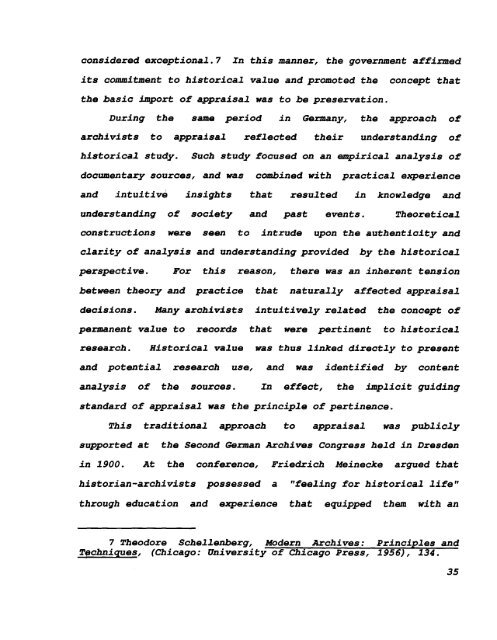A STUDY OF THE THEORY OF APPRAISAL FOR SELECTION By ...
A STUDY OF THE THEORY OF APPRAISAL FOR SELECTION By ...
A STUDY OF THE THEORY OF APPRAISAL FOR SELECTION By ...
You also want an ePaper? Increase the reach of your titles
YUMPU automatically turns print PDFs into web optimized ePapers that Google loves.
considered exceptional.7 In this manner, the government affirmed<br />
its commitment to historical value and promoted the concept that<br />
the basic import of appraisal was to be preservation.<br />
During the same period in Germany, the approach of<br />
archivists to appraisal reflected their understanding of<br />
historical study. Such study focused on an empirical analysis of<br />
documentary sources, and was combined with practical experience<br />
and intuitive insights that resulted in knowledge and<br />
understanding of society and past events. Theoretical<br />
constructions were seen to intrude upon the authenticity and<br />
clarity of analysis and understanding provided by the historical<br />
perspective. For this reason, there was an inherent tension<br />
between theory and practice that naturally affected appraisal<br />
decisions. Many archivists intuitively related the concept of<br />
permanent value to records that were pertinent to historical<br />
research. Historical value was thus linked directly to present<br />
and potential research use, and was identified by content<br />
analysis of the sources. In effect, the implicit guiding<br />
standard of appraisal was the principle of pertinence.<br />
This traditional approach to appraisal was publicly<br />
supported at the Second German Archives Congress held in Dresden<br />
in 1900. At the conference, Friedrich Meinecke argued that<br />
historian-archivists possessed a "feeling for historical life"<br />
through education and experience that equipped them with an<br />
7 Theodore Schellenberg, Modern Archives: Principles and<br />
Techniques, (Chicago: University of Chicago Press, 1956), 134.<br />
35
















